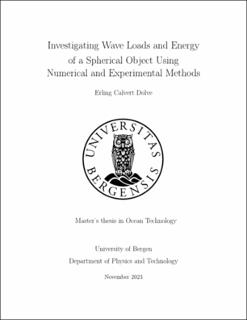Investigating Wave Loads and Energy of a Spherical Object Using Numerical and Experimental Methods
Master thesis
Permanent lenke
https://hdl.handle.net/11250/3109659Utgivelsesdato
2023-11-20Metadata
Vis full innførselSamlinger
- Master theses [159]
Sammendrag
The world is undergoing massive changes due to climate change. To combat this, renewable energy sources are required. Whereas solar, wind, and hydropower are viable alternatives, wave power offers more stability and is a largely untapped energy source. This thesis aims to contribute to further research on optimizing wave energy converters by analyzing the available energy in waves, wave loads, energy corresponding to the wave loads, and the percentage of available energy that can be harvested. This has been done using Computational Fluid Dynamics (CFD) and experimental testing in MarinLab, the hydrodynamic test facility at Western Norway University of Applied Sciences (HVL). A sphere with a diameter of 200 mm was used, and the loads in the horizontal drag direction and vertical lift direction onto the sphere were measured using two load cells. From CFD, the drag and lift forces, drag and lift coefficients, and the wet surface area projected by the water were extracted for velocity calculations.
The drag and lift forces, coefficients, and wet surface were used to calculate the energy related to the drag and lift forces. The force results showed that the drag force increased when the wave height and frequency were increased, while the lift force increased when the wave height increased, and decreased when the frequency was increased. The same trend was shown in the energy relating to the forces, as they are proportional. The theoretically available energy in the waves was calculated using hydrodynamic principles, and the ratio of energy related to the forces on the sphere to the theoretically available energy was studied. This energy harvesting ratio showed that, unlike the amount of energy from forces, the energy harvesting ratio decreased with increasing wave height, and increased with increasing frequency. This could be due to the wet surface interacting with a smaller area as the wave height increases, leading to a smaller amount of the available energy interacting with the sphere. The increasing frequency is in direct relation to a decrease in the available energy while interacting with the same wet surface. Thus, a larger portion of the available energy is absorbed by the sphere. These results could indicate that spherical wave energy converters are probably not the best-shaped converters for energy harvesting, but could be more resilient to damaging waves.
Utgiver
The University of BergenOpphavsrett
Copyright the Author. All rights reservedBeslektede innførsler
Viser innførsler beslektet ved tittel, forfatter og emneord.
-
Regulating Energy communities as new actors in the European energy market: Assessment of and justification for the legal treatment of energy communities compared to traditional market actors
Aarekol, Ingrid Roarsdatter (Master thesis, 2021-12-10) -
A System Dynamics Based Study of Policies on Reducing Energy Use and Energy Expense for Chinese Steel Industry
Longbin, Zheng (Master thesis, 2007)Chinese steel industry is one of the energy intensive industries in China. Coal and electricityare the two main energy sources for steel making. Steel industry in China is experiencing itstransition period because of economy ... -
Ren energi i urent farvann - regulering av fornybar energi til havs etter havenergilova
Hermansen, Ola (Master thesis, 2011-06-01)Hovedtema for denne oppgaven er regulering av fornybar energi til havs etter havenergilova. Oppgaven gir en analyse av hva loven regulerer, samt en vurdering av om reglene gir en hensiktsmessig regulering av energiproduksjon ...
